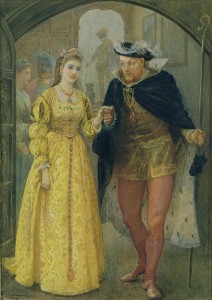
According to Eustace Chapuys, the Imperial ambassador, on Sunday 8th January, the day after Catherine of Aragon’s death, Henry VIII “was clad all over in yellow, from top to toe, except the white feather he had in his bonnet” and he paraded the two-year old Princess Elizabeth to mass “with trumpets and other great triumphs”.1 On hearing news of his first wife’s death, the King had cried out “God be praised that we are free from all suspicion of war!”2 because he now had no quarrel with Emperor Charles V, Catherine’s nephew, and could make an alliance with him if he wished to.
Chronicler Edward Hall puts Anne Boleyn in yellow, writing, “Quene Anne ware yelowe for the mournyng”,3 so it is impossible to know who was wearing yellow – Anne? Henry? Both of them? The only other contemporary source to mention the wearing of yellow is The Spanish Chronicle, which is notoriously inaccurate but reports that “as soon as the King heard of it [Catherine’s death] he dressed himself in yellow, which in that country is a sign of rejoicing.”4
Other contemporary accounts make no mention of either the King or Queen wearing yellow.
You can read more about this in my article Yellow for Mourning – The Reaction of Henry VIII and Anne Boleyn to Catherine of Aragon’s Death.
Notes and Sources
- LP x. 141
- Ibid.
- Hall’s Chronicle, Edward Hall, p818
- Chronicle of King Henry VIII of England (The Spanish Chronicle), translated by Martin A. Sharp Hume, p52